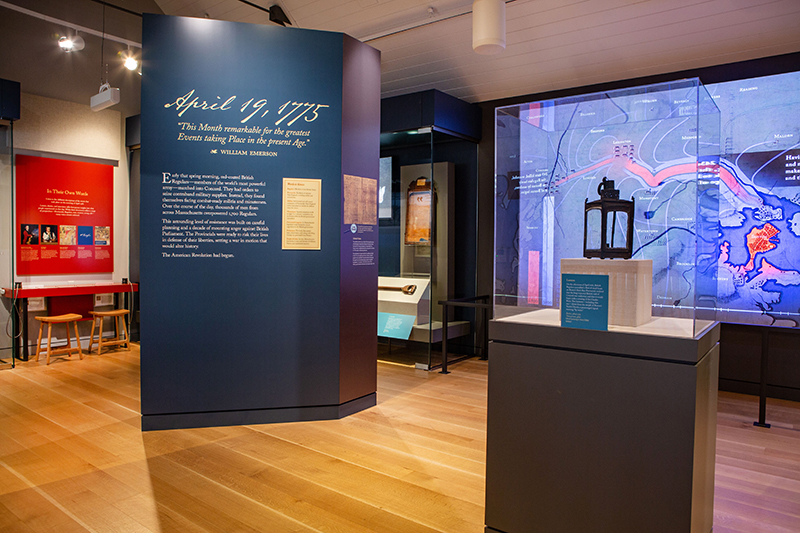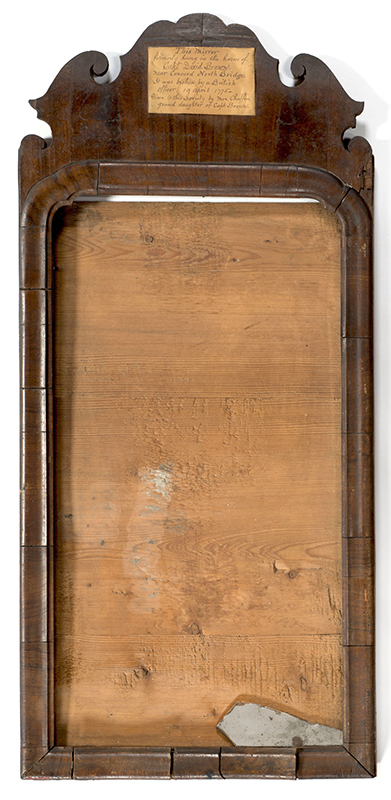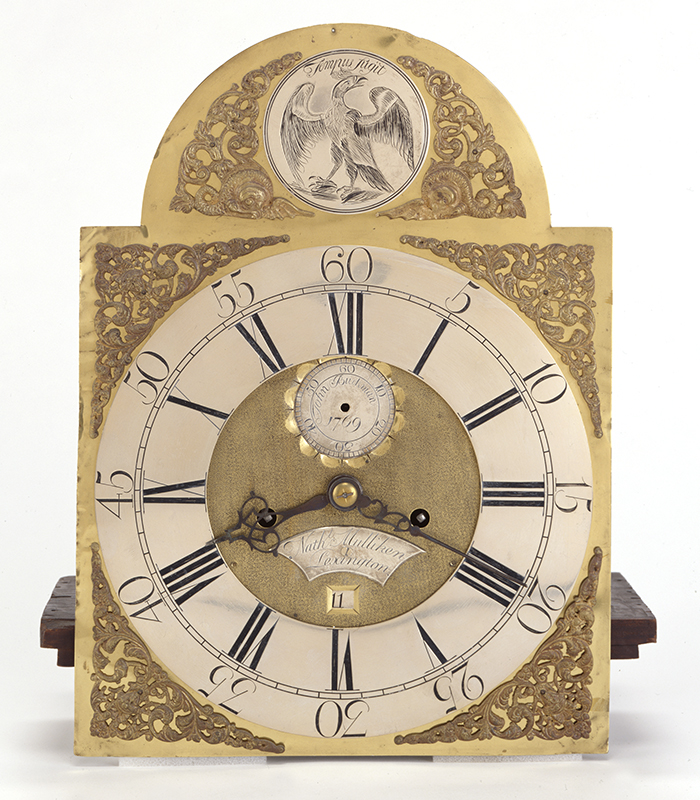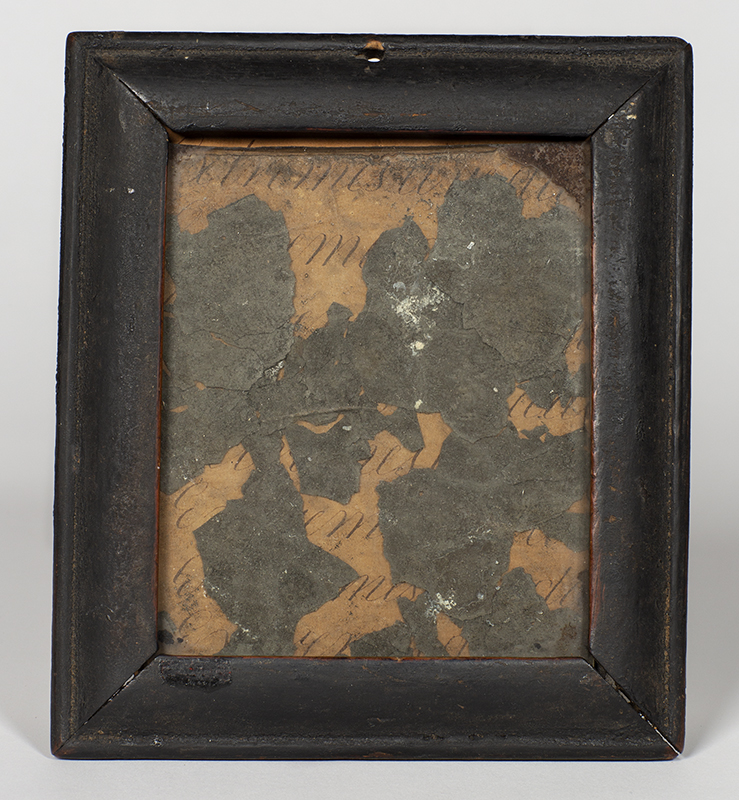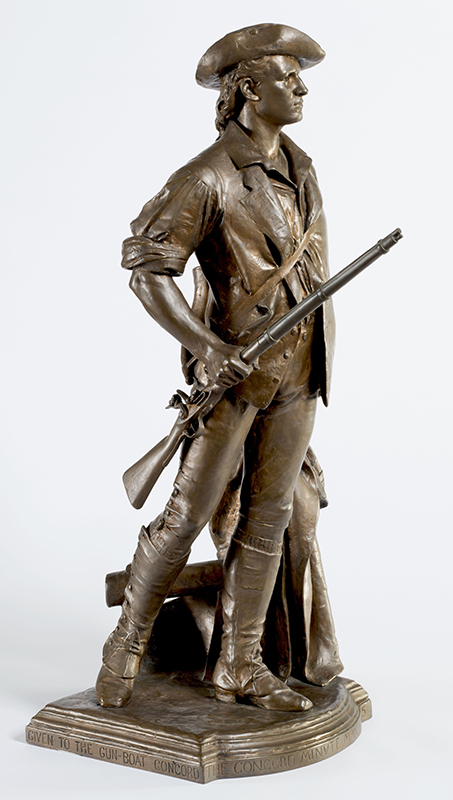Curating the Revolution
by Erica Lome, PhD
ON THE MORNING OF APRIL 19, 2021, a militia company came to Concord, MA. A crowd of visitors eagerly awaited them at the Concord Museum, where they also took in three new galleries titled April 19, 1775 (figure 1). These galleries explore the historic confrontation in Concord between British Regulars and Provincial Massachusetts militia, a day-long engagement that began the eight-year fight for American independence. For me, this day was the culmination of a year’s worth of hard work and joyful learning at the Concord Museum.
Last spring, I joined the Concord Museum through a two-year curatorial internship grant funded by the Decorative Arts Trust and the Gerry Charitable Trust. As the Peggy N. Gerry Curatorial Associate, my primary responsibility involves the redesign of 14 new permanent galleries. Working with outside partners and members of our curatorial team, I assisted with collections research, writing and editing text, object installation, and managing the project’s schedule.
With nearly 250 years of local history and popular culture to address, our primary goal with these galleries was to show our visitors exactly what happened on April 19, 1775. The Museum is fortunate to have the strongest collection of artifacts related to the Battle of Lexington and Concord thanks to the efforts of our founder, Cummings E. Davis (1816–1896), a descendant of one of Concord’s early colonists. He moved to Concord in 1850 and began acquiring materials that documented the history of his new hometown. In 1886, a group of dedicated townspeople formed the Concord Antiquarian Society to house his collection. Davis envisioned Concord as the proverbial birthplace of America and obtained iconic artifacts to support this narrative, including one of the two lanterns which hung in the North Church on April 18, 1775 (figure 2). Paul Revere coordinated this signal to alert riders of the British Regulars’ departure from Boston across the Charles River (or, as Henry Wadsworth Longfellow later memorialized, “by sea”).
The ultimate challenge posed by the Museum’s redesign was honoring Davis’s founding vision while centering new and diverse perspectives in our interpretation. We looked to the objects to guide our thinking. For April 19, 1775, objects act as “eyewitnesses” to the day’s events ground this larger-than-life story within a rich material setting. A broken looking glass, vandalized by British Regulars, acts a proxy for the violence inflicted on the Concord townspeople (figure 3). An old wooden door tells the story of Rebecca Barrett, who bravely confronted a company of Regulars alone at her farm. A tall case clock by Nathaniel Mulliken ticks away in the gallery, the very sound heard by the Lexington militia at Buckman’s Tavern as the Red Coats approached (figure 4). Two dozen flints arranged in two rows, just as they were found by archeologists, shows that the Provincials fired without hesitation on the Regulars at the North Bridge—a radical and revolutionary action. An ornate sword gleams, abandoned by a British officer on the bloody march back to Boston (figure 5). Even a humble stair tread, stepped on by Paul Revere’s signalman stationed at the North Church, gets to shine in this gallery.
Our secondary aim was, whenever possible, to let the participants of April 19 have the first and final word. Technology played a vital role in this endeavor. We worked with Richard Lewis Media Group (RLMG) to create elements based on two key sources: Amos Doolittle’s engraved depictions of four moments in the Battles of Lexington and Concord and De Costa’s c. 1775 map of Boston and its surrounding environs.
RLMG paired animations of the four Doolittle prints with descriptive quotes from eyewitnesses and subtle motion graphic treatments. For this component, I searched through pages and pages of first-person accounts to select engaging and accurate quotations. For the De Costa map, we created a large, printed mural onto which we project moving graphics. From our bird’s eye view, visitors see 24 hours of history told in six minutes. Storyboarding this animation acquainted me with every minute of the day.
While our artifacts provide a wealth of interpretive potential, we also needed to think critically about the stories we wanted to tell. The object record at the Concord Museum is weighted toward the most powerful members of 1770s society: land-owning white men. The contributions of women and those of lesser means are harder to track. The most significant omission, however, is that of people of color, especially the enslaved. I was particularly keen to explore the presence and participation of approximately 40 Black militiamen who fought for the Provincial cause on April 19, most of them alongside their enslavers. In considering the available objects, we found unique ways to center their lives and experiences throughout the gallery.
A musket and powder horn belonging to a Framingham minuteman became a surrogate through which to discuss Peter Salem, born into slavery in Framingham, who fought with the militia on April 19 and then at Bunker Hill, Saratoga, Monmouth, and Stony Point. Meanwhile, a looking glass (figure 6) belonged to Case Whitney, an enslaved man who died in 1822 at the age of 90. His enslaver, Samuel Whitney, was a delegate to the Massachusetts Provincial Congress and stored ammunition on his property. There’s little doubt that both Whitneys witnessed “the shot heard round the world” at the North Bridge. Case Whitney’s looking glass may have even followed him into military service as a volunteer in the Continental Army, through which he emancipated himself.
We also ask visitors to look closely at exhibition graphics to find underrepresented groups in the historic record. One Brookline payroll lists three enslaved men who fought on April 19, but identifies them via their enslaver, such as “Esq. Gardener’s Adam.” Meanwhile, a broadside listing the Provincial dead and wounded named the enslaved “Prince Estabrook, a Negro man” as one of the militia wounded on Lexington Common. This exercise puts visitors in the shoes of a historian, showing the evidence we use to reconstruct the past from the perspective of its almost-invisible participants.
In our interactive station, visitors examine a replica powder horn, like several on view in our gallery (figure 7). These horns frequently contained elaborate incised designs, the work of professional carvers, in a tradition stretching back to the French and Indian War. While earlier carved powder horns featured fanciful creatures or maps of forts, a bold and stylized copperplate script was the fashion by the 1770s, attributed to the work of John Bush, a free man of color from Shrewsbury, MA, who served at Fort William Henry. Bush’s decorated powder horns laid the groundwork for what’s now regarded as the Lake George School. His calligraphic style and decorative devices secured his reputation as one of the most important powder horn carvers in colonial America. Powder horns carved before and after April 19 feature several of his signature elements, suggesting that many of his decorated horns were brought back to Massachusetts and inspired carvers during the Siege of Boston.
One of the most rewarding aspects of this project involved reinterpreting some of the finest examples of Concord furniture in a gallery titled “The Revolution at Home.” We wanted to use these objects to challenge our visitors’ assumptions about the minutemen and their world. Concord’s white residents considered themselves British, not American. Their daily life reflected British fashions and customs, and this extended to their commercial pursuits, including the exportation of lumber, tobacco, and fur in exchange for goods and enslaved labor. In a town of about 1,500 people, at least 24 men, women, and children in Concord were enslaved. These message points are reinforced in the labels for our mahogany furniture, silver tea service, and Chinese silk upholstery.
From a decorative arts standpoint, these furnishings supply a host of information about the transmission of style from metropole to colony, and from city to country. For example, Joseph Hosmer (1735–1821), who owned the busiest shop in Concord, emulated Boston design in his furniture, including a c. 1770 high chest (figure 8). Yet, certain structural details, like the upper backboard and scrolled face board bracing the sides and the two-part cornice molding, are found on Boston furniture made 30 years earlier. In this respect, updated urban construction techniques had yet to make the 15-mile journey west.
Such details are significant for what they tell us about the people who lived and worked in Concord at the eve of Revolution. Despite their implied isolation, Concordians were keenly aware of the political developments taking place throughout the colonies and joined other towns in protesting English Parliament by boycotting imported goods. In fact, middling but respectable artisans such as Hosmer were among the more radical supporters of the Provincial cause, willing to risk their lives and livelihoods at the North Bridge.
By asking new questions of our objects, we also aimed to reframe narratives of ownership and agency. One of the more mysterious pieces in our collection is a chest-on-chest produced at Thomas Barrett’s sawmill by an unknown woodworker (figure 9). This elegant form belonged to the upper echelon of Concord society, but its construction was not at all typical. Most notably, the maker did not use any glue, thus adding many hours of work and extra expense to the building process, suggesting the maker was not compensated for their additional work, nor brought up within New England’s cabinetmaking tradition. The piece remained a mystery for years, but this project provided the opportunity for us to reexamine the chest’s construction and conduct research into the Barrett family. In consultation with historians John Hannigan and Robert Gross, who have investigated Concord’s involvement in the slave trade, we now suggest than an enslaved woodworker at Barrett’s sawmill made this chest, along with a dozen others, for Barrett to sell to the local market. Based on the inscribed date of 1776 on the inside of the chest, we can postulate that an enslaved maker may have even joined the extended Barrett family at the North Bridge on April 19, fighting for the liberties denied to others in their community.
The revolution began on April 19, 1775, but remains unfinished. In our final gallery, dedicated to Daniel Chester French’s Minute Man sculpture (figure 10), we show how the centennial commemoration in 1875 laid bare the ongoing issues over the rights of women, African Americans, and Indigenous people. As expressed by Louisa May Alcott, “There will come a day of reckoning…I devoutly wish that those who so bravely bore their share of that day’s burden without its honor…will utter another protest that shall be ‘heard round the world.’” I am excited to keep telling Concord’s story, including Alcott’s role in the fight for women’s rights, in 12 additional galleries set to open this summer. With so many more political, intellectual, and social revolutions to explore, I look forward to sharing more dispatches from the Concord Museum with the Decorative Arts Trust and remain grateful for the Trust’s commitment to creating opportunities for aspiring curators.
Erica Lome, PhD, is the Peggy N. Gerry Curatorial Associate, a position sponsored by the Decorative Arts Trust, at the Concord Museum.
A print version of this article was published in The Magazine of the Decorative Arts Trust, one of our most popular member benefits. Join today!

